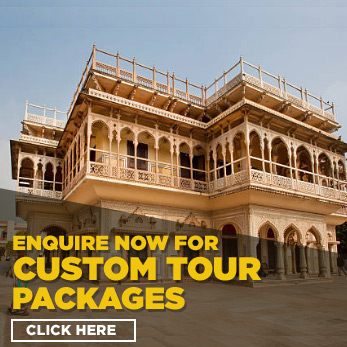Chittorgarh resonates with stories of Rajputana bravery, pride and passion. The bards of Rajasthan sing tales of courage and sacrifice recounting stories that are known to every child and adult in the city. Chittorgarh is named after its most imposing structure, the Chittorgarh Fort which stands atop a 180 metre high hill and is spread across 700 acres.
Chittorgarh Fort has had a tumultuous past. This bastion of the Rajputs has faced violent attacks thrice in its entire history. The first was in 1303 when the Sultan of Delhi, Ala-ud-din Khilji, who was enamoured by Queen Padmini, launched an attack to abduct her. More than two centuries later, in 1533, it was Bahadur Shah, the Sultan of Gujarat, who caused immense destruction. Four decades later, in 1568, Mughal Emperor Akbar attacked and seized the fort. It was finally in 1616, under the rule of Mughal Emperor Jahangir that the fort was returned to the Rajputs.
Tourist Places to Visit in Chittorgarh
Chittorgarh Fort is a fitting symbol of the Rajput spirit. Set atop a 180 metre high hill and spread across 240 hectares, this majestic fort features in tales of courage, pride and romance that the bards of Rajasthan have been singing for centuries. Legend has it that the construction of the Chittorgarh Fort was begun by Bhim, one of the heroic Pandava brothers from Mahabharata, India’s eminent mythological epic. The fort houses several magnificent monuments, some unfortunately ravaged by the passage of time. The imposing structure takes one back to the days of conquests and tragedies, and its walls continue to ring with incredible tales of extraordinary men and women. A one-kilometre road weaves its way from the foothills to the summit, taking visitors through seven gates before arriving at Rampol (Gate of Ram). On the road between the second and the third gate, visitors get to see two ‘chattris’ (cenotaphs) built in honour of Jaimal and Kalla, heroes, who laid down their lives in the 1568 siege by Emperor Akbar. The main gate of the fort is Surajpol (Sun Gate).
Rani Padmini's Palace
This palace plays an important role in Rajput history. The structure is built on the banks of a lotus pool and has a pavilion that provides privacy for the women of the royal family. Ala-ud-din Khilji, then Sultan of Delhi, spotted Queen Padmini’s reflection in the pool and was so besotted by her beauty that he led his forces in battle to abduct her.
Vijay Stambh
Vijay Stambh (the Tower of Victory) was built by Maharana Kumbha between 1440 AD and 1448 AD to immortalise his triumph of defeating the Muslim rulers of Malwa and Gujarat. Built partly from red sandstone and partly white marble, this architectural wonder is nine-storey tower decorated with detailed sculptures of Hindu gods and goddesses. Narrow steps lead to the terrace where one can catch a spectacular view of the entire town from the balconies.
Kirti Stambh
This Tower of Fame is dedicated to Adinathji, the 1st Jain Tirthankara (great teacher). Adorned by the figures of the Digambars (Jain monks), this seven-storied tower was built by a wealthy Jain merchant in 12th century AD.
Rana Kumbha Palace
A ruined edifice of great historical and architectural interest, this is one of the most massive monuments in the Fort of Chittor. The palace is believed to have underground cellars where Rani Padmini and other women committed ‘Jauhar’ (self-immolation).
Meerabai Temple
Meerabai, an ardent devotee of Lord Krishna’s, worshipped him at this temple. The structure is designed in the classic North Indian style of temples. It rises from a raised plinth and its conical roof can be seen from far. The temple houses a beautiful shrine surrounded by an open porch with four small pavilions in four corners
Fateh Prakash Palace
Constructed by Maharana Fateh Singh, this palace functioned as his residence. It was built in the Rajput style of architecture as a declaration of his taste for art and culture. The palace has a vast collection of wood crafts of Bassi village, post medieval statues of Jain Ambica and Indra from Rashmi village, weapons such as axes, knives and ancient shields, clay replicas of regional tribal people clad in their traditional costumes, paintings, and crystal ware. It has now been converted into a museum.
Jain Temples
The fort of Chittor has six Jain temples contained within its walls. The largest among them is the temple of Bhagawan Adinatha which has 52 ‘devkulikas’.
Kalika Mata Temple
Built in 8th century AD, this ancient structure was initially constructed to worship the sun god. In the 14th century, the temple was dedicated to Goddess Kali, the symbol of power and valour.
Tulja Bhavani Temple
Tulja Bhavani temple, an architectural wonder, is a Hindu temple of the goddess Durga, built in the 16th century by Banvir. Legend says that it is named after Banvir who donated various ornaments (Tula Dan) equaling his weight for relief funds.
Gaumukh Reservoir
Gaumukh Reservoir is a deep tank that is fed by a spring. The spring emerges from a rock formation resembling a Gaumukh or ‘cow’s mouth’. The tank is considered sacred by the locals.
How to Reach Chittorgarh
By Air: The nearest airport is Dabok Airport in Udaipur city which is about 105 kms away.
By Road: Regular buses are available to Chittorgarh from all major cities in Rajasthan.
By Train: Chittorgarh is connected by rail to and from Udaipur, Ajmer, Jaipur and Delhi.
Chittorgarh Images
- 5N-6D Golden Triangle Tour Package
- Golden Triangle Tour with Bharatpur
- Golden Triangle Tour with Golden Temple
- Golden Triangle Tour with Jaisalmer
- Golden Triangle Tour with Jodhpur
- Golden Triangle Tour with Jodhpur and Jaisalmer
- Golden Triangle Tour with Mandawa
- Golden Triangle Tour with Neemrana
- Golden Triangle Tour with Nimaj and Udaipur
- Golden Triangle Tour with Pushkar
- Golden Triangle Tour with Ranthambore
- Golden Triangle Tour with Royal Rajasthan
- Golden Triangle Tour with Udaipur
- Golden Triangle Tour with Varanasi





